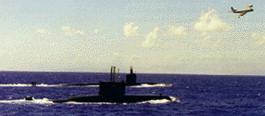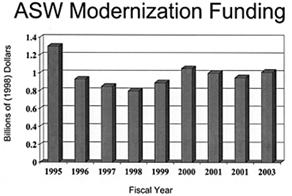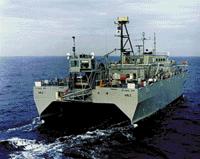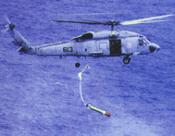by John Morgan, Captain U.S.
Navy
Anti-Submarine Warfare (ASW) remains the
linchpin of sea control. With forward presence and
expeditionary warfare rising to the top of Navy
priorities under the “New World Order,”
potential threats to our control of the intervening seas
are increasingly unacceptable. And since the
submarine threat is among the gravest of these, effective
ASW capabilities will be the sine qua non for our success
in future crises and conflicts. This is no less true now
than it was during the Cold War.
Despite the advance of technology, ASW
remains a complex challenge with neither simple nor
elegant solutions. Since the end of the Cold War and the
subsequent decline in defense budgets, however, that
challenge has become more severe. And yet, there are both
promising technical and operational developments and a
growing shift in attitude that deserve equal attention.
Indeed,
current and near-term future developments augur well for
greatly enhancing this important naval warfare area.
Today’s ASW Legacy
Like many other major issues facing today’s Navy,
our current concerns about ASW trace back to the end of
the Cold War and our subsequent redirection of emphasis
toward potential conflict in the littorals. Our existing
ASW capabilities are largely those that had been so
painstakingly created to prevail over the Soviets in a
global, deep-water conflict, and they are only partially
adequate for the new and different environments we face
today. Shallow water, near-shore oceanographic phenomena,
asymmetric diesel and advanced Air-Independent Propulsion
(AIP) submarine threats, and meager information about the
potential battle space all contribute to significant
uncertainties about our ability to contain the new and
different undersea threat we face now. Further, since the
Russian Navy has continued to build state-of-the-art
nuclear submarines with global reach, the “Cold War”
threat, though numerically smaller, remains to be
countered also.
Yet today, ASW seems to some observers to
be a tennis match with no opponent on the other side of
the net. With the end of the Cold War and the
simultaneous implosion of the Soviet/Russian navy, we are
no longer seriously challenged at sea, except perhaps by
local naval powers intent on acquiring modern submarine
forces or new mine warfare capabilities. Consequently, we
have not been able to practice ASW very realistically.
Also, although our equipment has grown older and less
effective, we have not noticed much impact, because the
challenge has been so minimal. Nevertheless, the Navy’s
ASW proficiency has declined in the last decade, and we
must reassess future requirements and capabilities to
meet an uncertain but still-dangerous threat.
The New ASW Assessment
Under the pressure created by a similar ASW crisis early
in World War II, the Navy regrouped by establishing the
Tenth Fleet to coordinate an integrated response to the
threat. Within three years, the Allies had won the Battle
of the Atlantic. Now, with the recognition that ASW
challenges are steadily increasing world-wide, the Navy
is regrouping again. With “coordination” and
“integration” as key elements, the
Anti-Submarine Warfare Division (N84) in the Office of
the Chief of Naval Operations has been given a central
responsibility for developing a requirements-based ASW
plan, as a direct outgrowth of the Navy’s recent ASW
assessment.
There are three fundamental truths about
ASW. First, it is critically important to our strategies
of sea control, power projection, and direct support to
land campaigns. The Chinese military strategist Sun Tzu
recognized some 2,400 years ago that the best way to
defeat an enemy is to attack his strategy directly. As
the United States looks to refine its focus on forward
presence and power projection from the sea, as envisioned
in the 1994 Forward...From the Sea strategic concepts
paper, the submarine threat that denies, frustrates, or
delays sea-based operations clearly embodies Sun Tzu’s
dictum and attacks our strategy directly.
During the 1982 Falklands conflict, for
example, the Royal Navy established regional maritime
battlespace dominance with a single submarine attack, the
sinking of the Argentine cruiser General Belgrano by the
nuclear attack submarine Conqueror. But the British were
fighting at the end of a perilously thin, 8,000-mile long
logistics lifeline, and themselves were extremely
vulnerable to submarine attack. Had the single Argentine
Type 209 submarine that got underway, San Luis, been
successful in just one or two of its several attacks
— which were stymied as a result of an improperly
maintained fire control system — and sank or
seriously damaged one of the two British small-deck
carriers or several logistics ships, the outcome might
have been very different. We must recognize that in today’s
and tomorrow’s conflict scenarios, the submarine is
an underwater terrorist, an ephemeral threat. It will
force us to devote a great deal of resources and time,
which we might not have.
Second, ASW is a team sport —
requiring a complex mosaic of diverse capabilities in a
highly variable physical environment. No single ASW
platform, system, or weapon will work all the time. We
will need a spectrum of undersea, surface, airborne, and
space-based systems to ensure that we maintain what the
Joint Chiefs of Staff publication Joint Vision 2010 calls
“full-dimensional protection.” The undersea
environment, ranging from the shallows of the littoral to
the vast deeps of the great ocean basins — and polar
regions under ice — demand a multi-disciplinary
approach, subsuming intelligence, oceanography,
surveillance and cueing, multiple sensors and sensor
technologies, coordinated multi-platform operations, and
underwater weapons. Most impor-tantly, it takes highly
skilled and motivated people.
Finally, ASW is hard. The San Luis
operated in the vicinity of the British task force for
more than a month and was a constant concern to Royal
Navy commanders. Despite the deployment of five nuclear
attack submarines, 24-hour per day airborne ASW
operations, and expenditures of precious time, energy,
and ordnance, the British never once detected the
Argentine submarine. The near-shore regional/littoral
operating environment poses a very challenging ASW
problem. We will need enhanced capabilities to root
modern diesel, air-independent, and nuclear submarines
out of the “mud” of noisy, contact-dense
environments typical of the littoral, and be ready as
well to detect, localize, and engage submarines in deep
water and Arctic environments.

Exercises with high-end diesel subs,
such as the South Korean ROKS
Lee Jong Moo (SS-66), shown here with a P-3C and
USS Columbus (SSN-762) during RIMPAC 98,
are vital to improving Fleet ASW proficiency.
The 1997 ASW Assessment gathered inputs
from Fleet operators the intelligence and technical
communities, and the Navy and Joint Staffs. The study
team framed their effort by postulating several likely
future ASW campaign scenarios involving U. S. coalition,
and adversary forces and estimating the outcomes using
both analytical and simulation techniques. Lessons
learned were couched in accordance with the traditional
responsibilities of the Navy Department to “train,
organize, and equip” a navy. Strengths and
weaknesses were identified in each area, with mixed
results. The “good news” is that our equipment
— the platforms, sensors, weapons, and C4I
infrastructure planned for the coming decade — is
quite good. Though much remains of the Cold War,
deepwater legacy, it creates a solid foundation upon
which to build the enhancements needed for effectiveness
in the littoral, and new information processing
technologies will help fill the remaining gap. On the
other hand, today’s ASW training is deficient for
reasons described above, and our command organization for
coordinating multi-platform ASW and supporting it with
Intelligence, Surveillance, and Reconnaissance assets
ashore could be improved. In seeking to be better
organized, the fact that our present approach is so
platform-oriented is a major stumbling block.
The Way Ahead
Based on the findings of the 1997 assessment, the Navy is
now developing a set of integrated ASW requirements,
designing a mission architecture in response, and
drafting a corresponding investment plan for the
out-years. As the architecture, size of the force, and
capabilities will be requirements-based, the starting
point needs to be our best estimate of the submarine
threat 15 years or so from now. At that time, a likely
regional adversary may well be able to deploy 35-40
modern submarines in a mix of nuclear, diesel, and AIP
types, most equipped with respectably modern sensors and
weapons from the international arms market. In this
light, and in a time of constrained resources, the
overall ASW strategy most appropriate for future
expeditionary warfare may well be some kind of “moving
area control.” This would guarantee local undersea
superiority or time-limited sub-free “havens”
in areas of current interest, rather than the regional,
if not global, superiority we sought during the Cold War.
Thus, by successively concentrating forces and ISR assets
only where needed for Sea Lines of Communication (SLOCs)
or force protection, our forces can be focused optimally
and their limitations at least partially finessed. The
integrated ASW requirements, the mission architecture,
and the long-range investment plan are all currently in
work and will be updated continually to shape the Navy’s
response to the evolving submarine threat.

Regrouping for Success
In retrospect, this period of the late 1990s will be
viewed as a period of retrenching for ASW in the U.S.
Navy. The new challenge is becoming clearer, and it is
time to shift gears. Even though much of the Cold War
threat is gone, the Navy has not failed to appreciate the
future importance of ASW as a contributor to achieving
the visions articulated in Forward...From the Sea and
Joint Vision
2010. Other important policy documents — the Defense
Planning Guidance (DPG) and the Navy’s Long-Range
Planning Objectives — also call for a robust ASW
capability that links warfare requirements to the real
dangers and vulnerabilities introduced by the
proliferation of next-generation submarines. Evidence of
the Navy’s revitalization of ASW is beginning to
accumulate.
For example:
Senior Leaders are
Engaged.
The Chief of Naval Operations has
testified before Congress that submarines and
mines are among the most serious threats to the
U.S. Navy. He chaired a CNO Executive Board (CEB)
on ASW in July 1997. Along with Secretary of the
Navy John Dalton, the CNO signed the 1997 ASW
Assessment, which was forwarded to the Congress
earlier this year. Excerpts from CNO’s more
recent ASW “focus” statement are found
in an accompanying sidebar. Most importantly, the
CNO has led the way in providing stable funding
for ASW accounts ever since he took office.
Following up, Fleet Commanders are revamping ASW
training and experimenting with new technology.
There is a growing awareness by all echelons of
the Navy’s leadership that the cycle of ASW
is on the upswing.
Funding has
stabilized.
Despite the challenge of ensuring
today’s readiness while investing in the
future, current funding projections show that the
Navy is serious about modernizing ASW systems,
sensors, and weapons.
New technology is
continually being developed and fielded.
The Navy is experimenting with
several new acoustic and non-acoustic
technologies especially tailored to the littoral
environment. A few examples include:
Distant Thunder.
This is a new body of advanced signal processing
techniques for shallow water, littoral
environments that uses innovative computer
processing to detect target echoes generated by
low frequency active sources.
Interactive
Machine-Aided Training (IMAT).
This is an exciting new training approach that
uses computer-generated visualizations of
underwater sound fields and propagation phenomena
to develop operator intuition and greater
understanding of sonar conditions and sensor
effectiveness.
Advanced Rapid COTS
Insertion (ARCI).
The submarine community is leading the way in
introducing commercial off-the-shelf (COTS)
computer technology into its ASW systems and
sensors, and processing gains are dramatic. For
example, when all ARCI builds are installed in an
Improved Los Angeles (SSN-688I) attack submarine,
that single SSN will command as much
signal-processing power as the entire non-ARCI
SSN-688 fleet at sea today.
Advanced Deployable
System (ADS). ADS is a rapidly
deployable, short-term undersea surveillance
system designed for ASW monitoring of shallow
water littoral operating areas. It will use an
expendable, battery-powered, large-area field of
passive acoustic arrays, interconnected and
cabled to shore with fiber-optic cables.
Rapid Environmental
Assessment. The Ocean-ographer of
the Navy is developing techniques and procedures
to assess the ASW environment of the littoral
battlespace for rapid optimization of sensors and
weapons and decision support. Remote offboard
sensors and satellite signal processing play key
roles.
Advanced Technology
Demonstrations (ATDs). ASW projects
have fared well in recent years in this important
program that encourages high-risk projects that
offer potential for high payoff.
The Navy is articulating
more focused ASW requirements.
The undersea warfare community is
pioneering a new approach to defining warfare
requirements that uses a “systems integrator”
process. While developing the budget, ASW program
planners now treat the entire architecture as a
whole, recognizing that effective ASW requires a
chain of systems that can only be as strong as
its weakest link. Future budgets will be
determined by an investment strategy that seeks
to strengthen the weak links while exploiting
promising opportunities in training,
organization, and technology.
Prospects for the Near Term
Despite this evidence of recent progress, there remain
several shortfalls that could be addressed by additional
near-term initiatives. Most notably, we are studying the
creation of an ASW “center of expertise” at the
numbered fleet level, which would hold responsibility for
ASW training, the development of multi-platform
coordinated tactics, and experimentation. This
organization could have the power to control real assets
— much as did Tenth Fleet in World War II — and
certify each deploying battle group in integrated ASW
proficiency that includes the exploitation of ISR assets,
such as the Integrated Undersea Surveillance System
(IUSS). We need regular access to an “adversary
squadron” of modern diesel-electric submarines, and
we ought to make maximum use of allied and friendly
navies to fill the need, subsidizing them if necessary.
As a “force-multiplier” for our limited
platform assets, we should be looking at more commonality
of ASW sensors and signal processors, with open, “plug-and-play”
architectures that facilitate flexible applications on a
variety of platforms. Finally, the U. S. Coast Guard’s
“Deepwater” initiative for providing a “system
of systems” for missions beyond 50 miles offshore
— and which will include both a new “Maritime
Security Cutter” and several aircraft types —
may offer significant opportunities for littoral ASW
mission and asset sharing.
Overall, ASW is finally emerging from a
decade of atrophy. Acknowledging and understanding ASW’s
recurring cycles of “boom-and-bust” can
accelerate the awakening that is now underway in the
Navy. We need to avoid any further unraveling that could
permit the kind of devastating blows that history has
shown can be fatal to a national military strategy that
relies so heavily on unimpeded sea lines of
communication. The Battle of the Atlantic in 1942-1943
and the Falklands War of 1982 have shown what is at
stake.
A Rising Tide
ASW embodies the essence of sea control, which in turn
remains the foundation for global power projection. The
Chief of Naval Operations clearly understands the
importance of both: “In fact,” as Admiral
Johnson noted, “at the core of U.S. security
requirements lies one prerequisite — sea control….
If we cannot command the seas and airspace above them, we
cannot project power to command or influence events
ashore; we cannot deter; we cannot shape the security
environment.”
We are awakening to the demands and tasks
ahead. There is renewed interest by the Navy’s
leadership in core ASW competencies. Our intelligence
services and operating forces are, once again, focused on
the new generation of an old and familiar threat. Our
technical community is addressing novel solutions to a
complex, multi-faceted problem. In short, ASW is coming
back. The greatest challenge now will be holding us
“steady as she goes” on the course to recovery.
SURTASS ship USNS Able
(T-AGOS-20)

Captain John Morgan is the Director,
Anti-Submarine Warfare Division (N84), in the Office of
the Chief of Naval Operations. A Surface Warfare Officer
qualified in submarines, he has extensive multi-platform
ASW operational experience.
|




